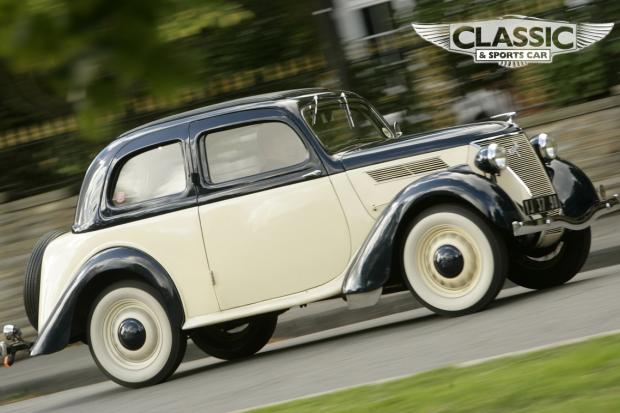
The Eifel was a modernised German version of the 10hp Model C Ford, built in Cologne. Jon Pressnell samples the only example in Britain, and is pleasantly surprised.
You can bet that more than a few Ford enthusiasts have done a double-take when seeing the 10hp Ford of London taxi-driver Jim Miles. It looks at first glance like a Model C, but then you notice the duo-tone paint, the elegant V8-like front, the pressed-steel wheels – oh, and the built-out boot. A clever custom? Not a bit of it: Jim’s car is a German-made ‘C’, as produced at Ford’s Cologne works from 1935-’39. That makes it a real rarity: barely 200 are thought to survive, and this is the only British-domiciled example.

Ford had begun assembly in Berlin in 1926 and, as part of its plans for an integrated European operation, had opened a large factory in Cologne in 1931 – just in time for the early-’30s depression. Sales of the big Model A plummeted, and only barely recovered with the Model B. As in England, the modest 933cc Model Y was seen as the plant’s saviour: assembly of CKD kits from Dagenham started at the beginning of 1933.

This was purely a stop-gap, as ever more draconian import restrictions meant that Ford had to source everything it could from within Germany rather than assembling parts brought in from Dagenham, as it wished. The sums didn’t add up. But to stay in the market, management in Dearborn had to accept German manufacture of everything from the body to the engines. The result was the Ford Köln – built between 1932 and ’36. Home-market sales in that period were a paltry 6500 or so cars, out of a total production quoted as 10,050 or 11,121, so the German-flavoured ‘Y’ – available as a saloon, a soft-top and a cabriolet – can hardly be counted a success.

Perhaps the cheap Opel P4 was too serious a competitor. But whatever the reasons, the German 10hp Model C entered production in 1935 – and soon displaced the Köln. Called the Eifel, the Cologne-built ‘C’ was offered only as a two-door. In compensation, body styles encompassed a saloon and a typically German convertible-top saloon (by Drauz), plus a drophead (by Gläser for 1935-’37 and by Deutsch thereafter) and a roadster by Stoewer (1936), by Ford itself (1937) or by Karmann, which made more than 1000 such bodies from the 1938 model-year onwards. There was also a van, while German expert Wolfram Düster has recorded 15 different coachbuilders who gave the Eifel special bodywork.

Local content was calculated at 99.6%. This was good enough for Reichsmarshall Hermann Göring, the strutting Nazi supremo buying himself a cabrio-saloon at the 1936 Berlin motor show – ahead of the Eifel’s 1937 certification as being of fully German origin and thus entitled to carry the Deutsches Erzeugnis (‘Made in Germany’) badge. By 1938 Ford had climbed to fourth in the German market, behind Opel, DKW and Mercedes – albeit with a market share of 11%, well below Opel’s 40%.

At first the Eifel resembled its British progenitor, but for 1937 it gained a restyled front modelled on that of the Model 62 V8. At the same time it was given 16in pressed-steel wheels in place of the previous 17in wires, and that built-out boot. The new front brought with it an alligator bonnet with the side panels rising with the lid, but for 1938 the side panels were fixed – making access to some components less than easy. Electric wipers also made an appearance, in place of the legendarily dreadful vacuum-operated items British sidevalve Fords had to suffer. These various titivations at least modernised the car a little, while Ford tried to amortise its investment: it should be remembered that in March 1937 Dagenham had replaced its ‘C’ with the more up-to-the-moment 7W model.

A founder-member of the Ford Y & C Model Register, Jim Miles found his 1937 Eifel seven years ago, at a Danish classic car dealer. It was sound but pretty rough, having been owned for many years by a local farmer, who only sold the car when he went into an old people’s home: “It had VW Beetle bumpers, big orange flashers, holes drilled in the bulkhead for heater hoses, and the interior had been covered in emulsion paint to make the cloth look like ’50s Bakelite. The farmer had also welded a tin panel over the fabric centre section of the roof, and smothered it with filler. I had to chisel all that off.”




